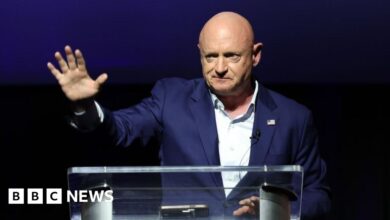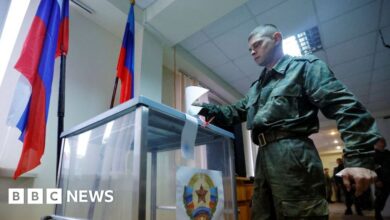As Dolphins Die in Black Sea, Ukraine Builds Case for Ecocide Against Russia

The victim was found along a stretch of beach near the port city of Odesa in southern Ukraine early this summer, cause of death unknown.
As a light rain fell in the open field where the necropsy would take place, law enforcement officials, a representative of the local prosecutors’ office and civilian witnesses gathered to watch.
On the beach was a harbor porpoise. They are washing up dead in droves on the shores of the Black Sea.
“Dolphins are not only cute creatures,” Pawel Goldin, 44, a doctor in zoology who specializes in marine mammal populations at the Ukrainian Scientific Center of Ecology of the Sea, said before the necropsy. “They are keystone creatures for the marine ecosystem. If dolphins are in a bad condition, then the entire ecosystem will be in a bad condition.”
And the dolphins in the Black Sea are in trouble.
Ukrainian officials say their plight speaks to the savage toll that Russia’s war is taking on marine life and the environment more broadly — something they want to document for prosecution.
Currently, four specific acts — genocide, crimes against humanity, aggression and war crimes — are recognized as international crimes. Ukraine would like to add a fifth — ecocide — and it is setting out to build its case against Russia. The autopsy of the porpoise was part of that effort.
“We right now are developing the strategy for the prosecution of environmental war crimes and ecocide,” said Maksym Popov, an adviser to the Prosecutor General of Ukraine, who is specifically focused on environmental issues. “It’s not established yet.”
While people often refer to porpoises and dolphins interchangeably, they are distinct creatures that are both endangered.
The attempt to document and prosecute atrocities in Ukraine is a sprawling effort, and the government in Kyiv, the capital, is being assisted by experts from the United States, Britain and the Europe Union. There are tens of thousands of registered war crimes under investigation, including the killing of innocents; the destruction of civilian infrastructure and whole towns; cases of kidnapping, torture and rape; and the forcible deportation of men, women and children.
Even with so much suffering to document, Ukraine’s atrocity advisory board has also dedicated resources to the investigation and prosecution of environmental crimes.
“The environment is often called the silent victim of war,” Mr. Popov said. Ukraine is trying to change that, since “the environment has no citizenship, no borders.”
In a sign of the importance that Kyiv is placing on the issue, President Volodymyr Zelensky has included “immediate protection of the environment” in the 10-point peace plan Ukraine hopes will provide a foundation for negotiations to end the war.
Ruslan Strilets, Ukraine’s minister of environmental protection and natural resources, said in an interview that environmental investigators had collected data related to more than 900 cases of dead dolphins. The figure includes those found on the shores of Ukraine, as well Turkey and Bulgaria, which also border the Black Sea.
In one week in July, he said, 10 dolphins were found and are being studied to determine how they died.
“This is a new challenge for wartime,” he said. “We can’t lose any information about environmental crimes.”
The destruction of the Kakhovka dam, which sent trillions of gallons of polluted water down the Dnipro River and into the Black Sea, was the most serious blow to the environment in an already ecologically catastrophic war. But even before then, dolphins were dying at an alarming rate.
Russian warships menacing the southern coast of Ukraine in the Black Sea make constant use of acoustic sonar signals that scientists say can interfere with dolphins’ sense of direction, since they use their own natural sonar for echolocation.
Explosions, rocket launches and low-flying Russian fighter jets only add to the cacophony traumatizing the dolphins, Dr. Goldin said. But he cautioned that it was far too early to directly link the dolphin die-off to a single cause.
Maritime mines littering the coastal waters present new, deadly obstacles. Pollutants from explosives and fuel leaks, along with an assortment of flotsam associated with war, have spoiled vast swaths of the Black Sea Biosphere Reserve — Ukraine’s largest protected area that is classified as a “wetland of international importance.” And the environmental toll caused by the sprawling consequences of the dam break is still being intensively studied.
Dr. Goldin said the floodwaters included heavy metals, pesticides and nutrients — nitrogen and phosphorus in particular — that had built up in the sediment behind the dam. Those nutrients triggered a massive algae bloom, which can become toxic.
A major study of the Cetacean population of the Black Sea in 2019 found that there were about 200,000 harbor porpoises, 120,000 common dolphins and 20,000 to 40,000 bottlenose dolphins, Dr. Goldin said.
While some environmentalists have speculated that more than 50,000 Black Sea dolphins could have died in the first year of the war alone, the scientists involved in the forensic examinations are more cautious.
Dr. Goldin said it was not yet possible to estimate how many dolphins had died as a direct result of the war, and Ukraine is working with international partners to better understand what is happening.
Ukraine has had to create new methodologies to document damage to the environment, Mr. Strilets said. The Black Sea is a battle zone, large sections of the Ukrainian coastline are under Russian occupation, and many areas are too dangerous to visit because of heavy fighting.
But it is one thing to document a dead dolphin washing ashore. It is a vastly more complicated matter to understand why the animal died.
“The diagnosis is the result of all steps of all the research,” Dr. Goldin said.
After each necropsy, Ukraine sends samples to experts at the University of Padua in Italy and the University of Hannover in Germany for further analysis.
That work will take time, Dr. Goldin said. And it is only after the war, when a large-scale survey of marine life in the Black Sea can take place, that the true toll will be known.
Still, each dolphin death they document and study offers important clues.
The porpoise dissected this summer had died a few weeks earlier, days after the destruction of the dam. With Ukraine’s resources stretched thin, it had to be frozen until officials could perform an autopsy in accordance with the protocols for both a scientific and criminal investigation.
“This is a small guy,” Dr. Goldin said as his team laid the porpoise out on a table to thaw. A powerful odor was overwhelming even in the open air as they cut the creature apart.
When the necropsy was done, Dr. Goldin said that one surprise was that the porpoise’s stomach was full and it had recently eaten at least five species of fish.
“To eat so much food showed he was ready for life,” Dr. Goldin said. “It is intriguing because it adds to the mystery of why he died.”
Dr. Goldin was hopeful they would begin to get a better overall picture of what was happening to the dolphins in coming months, but said that “the best agent of nature conservation now is the Ukrainian Army” since it was only when the war ended that the destruction would stop.
“Maybe we were not the best stewards, but we are truly shocked by what the Russians do to nature,” he said. “The sooner the Ukrainian Army takes control over the Black Sea, the sooner the environment in the Black Sea will begin to heal.”




